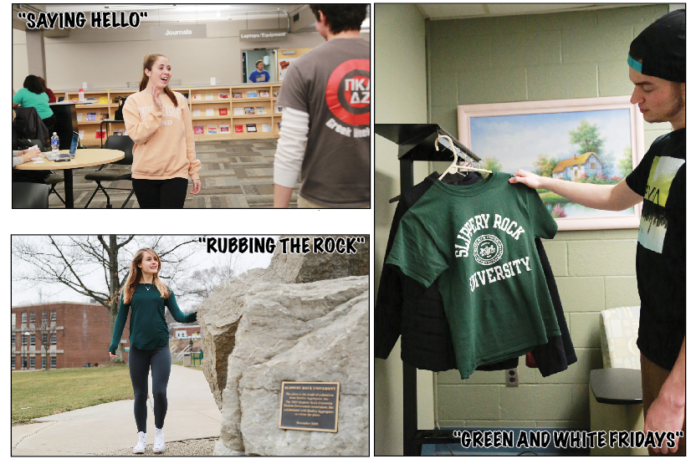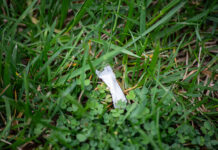Timeless traditions of Slippery Rock University have been dated back to as far as the 1920s for students to read upon in the archives of Bailey Library and also to experience every day.
Junior early childhood education and special education major and Green and White Society’s Vice President of Traditions, Alyssa Trocci said Slippery Rock wouldn’t be what it is without its students and traditions.
There are four main traditions of SRU that are routinely used by students and Green and White society members on the daily.
The first is the “hello” tradition. This tradition creates a warm environment and also a sense of pride in the community, Trocci said. This practice entails saying hello whenever a person passes another at any time.
The first record of this tradition was in the 1938-39 academic year in the green and white handbook.
It is simply a nice thing to do, it doesn’t take much at all to say hello to someone, Trocci said.
Director of special events and advisor for Green and White Society, Deborah Baker said the hello tradition is considered the essence of Slippery Rock spirit.
“When we meet with alums, they always say how much of a welcoming and pleasant campus this was for them,” Baker said.
The second tradition is Green and White Fridays.
This involves students, faculty, staff and whoever supports the university wearing green and white or Slippery Rock attire on Fridays.
This tradition is not documented but it is assumed that it started back in the 1940s when Slippery Rock clothing became available to wear.
“You should be proud to go to Slippery Rock, and showing that to the community gives the university an even bigger sense of pride,” Trocci said.
The third tradition is “Rub the Rock.” The rock in the middle of the quad on campus is said to have “magic powers,” Trocci said. The story says that if you rub it during a midterm, test or anything important coming up, that it will give you good luck.
The rock has less history than Green and White Fridays, but it has been a part of the entire development of the campus.
“It has become a part of historical speculation,” Baker said.
The magic rock has evolved with the expansion of the university, while other rocks have been added and placed on the campus as well.
There are four other rocks that are also symbolic to the students. Although these rocks don’t necessarily have to do with the traditions, they represent a student’s time at Slippery Rock. Placed near Weisenfluh to the bottom of the steps by the Jack-Dinger Building, four rocks represent each class.
The first rock, representing the freshman, starts out rough and bumpy and transforms all the way to the fourth rock, representing the seniors, which is perfectly rounded. The meaning of the rocks shapes is easily understood by the students.
The final tradition is the alma mater and fight song. The alma mater was written by Adda M. Elliott in 1921. The fight song was written in 1928, but has evolved throughout the years, and has been symbolic to the change and growth of Slippery Rocks relevance today.
Sophomore information technology major and member of Green and White Society, Sydney Cipolla said Green and White Society sing the alma mater at every single meeting.
“We try to encourage students to learn it and know it by the time they graduate so they can sing it at graduation,” Baker said.
The majority of the students know what the traditions of Slippery Rock are, but to help gain a bigger sense of pride and community, the Green and White Society hosts tradition events for students.
During times like common hour, ambassadors have a wheel that they set up in the student center and other places where students can win prizes if they correctly answer a question about history and traditions of SRU, Cipolla said.
Another place to help students is the archives office on the third floor of Bailey Library, where students can look at old handbooks, books, pictures and more on the history of SRU.







